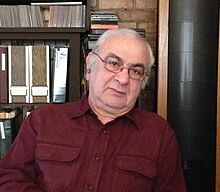모사프리드
Mosapride | |
 | |
| 임상자료 | |
|---|---|
| AHFS/Drugs.com | 국제 마약 이름 |
| ATC 코드 | |
| 식별자 | |
| |
| CAS 번호 | |
| 펍켐 CID | |
| IUPHAR/BPS | |
| 드러그뱅크 | |
| 켐스파이더 | |
| 유니 | |
| 케그 | |
| 체비 | |
| 켐벨 | |
| CompTox 대시보드 (EPA) | |
| ECHA InfoCard | 100.127.999 |
| 화학 및 물리적 데이터 | |
| 공식 | C21H25CLFN3O3 |
| 어금질량 | 421.90 g·190−1 |
| 3D 모델(JSmol) | |
| |
| |
| | |
모사프리드는 선택적 5HT4 작용제 역할을 하는 위스트로키네틱제다. M1로 알려진 모사프라이드의 주요 활성대사물은 5HT3 길항제 역할을 추가로 해 인간의 위장관 전체에서 위 비우기를 가속화하며,[1][2] 위염, 위장 역류증, 기능장애[3], 과민성 장증후군의 치료에 쓰인다.[4] 빈속에 복용하는 것이 좋다(즉, 음식 전 1시간 또는 음식 후 2시간 이상).[5]
모사프라이드는 그것의 prokinetic 특성 외에도, 위장관에 항염증 효과를 발휘하여 그것의 치료 효과의 일부에 기여할 수 있다.[6] 모사프리드는 또한 특정 장 질환에 유용한 것으로 판명될 수 있는 위장관의 신경 유전자를 촉진한다.[7][8] 신경유전증은 모사프라이드가 작용하는 5-HT4 수용체에 작용하기 때문이다.[9]
그것의 일반적인 부작용은 건조한 입, 복통, 어지럼증, 두통, 불면증, 불면증, 우울증, 메스꺼움, 설사 그리고 때때로 변비를 포함한다.[3][10] 모사프라이드는 다른 프로키네틱스 제제와 달리 칼륨 채널에 거의 영향을 주지 않고 hERG 전이세포에 영향을 주지 않으며 인간에 대한 실험에서 검출될 수 있는 심혈관 기능에 영향을 주지 않는다.[1][11] 모사프라이드의 약동학 때문에 심혈관계 효과를 이끌어내기 위해서는 치료용량의 1,000~3,000배가 필요할 것이다.[12]
참조
- ^ a b Tack J, Camilleri M, Chang L, Chey WD, Galligan JJ, Lacy BE, et al. (April 2012). "Systematic review: cardiovascular safety profile of 5-HT(4) agonists developed for gastrointestinal disorders". Alimentary Pharmacology & Therapeutics. 35 (7): 745–67. doi:10.1111/j.1365-2036.2012.05011.x. PMC 3491670. PMID 22356640.
- ^ Odaka T, Suzuki T, Seza A, Yamaguchi T, Saisho H (August 2006). "[Serotonin 5- HT4 receptor agonist (mosapride citrate)]". Nihon Rinsho. Japanese Journal of Clinical Medicine (in Japanese). 64 (8): 1491–4. PMID 16898619.
- ^ a b Curran MP, Robinson DM (2008). "Mosapride in gastrointestinal disorders". Drugs. 68 (7): 981–91. doi:10.2165/00003495-200868070-00007. PMID 18457463.
- ^ Mizuta Y, Shikuwa S, Isomoto H, Mishima R, Akazawa Y, Masuda J, et al. (November 2006). "Recent insights into digestive motility in functional dyspepsia". Journal of Gastroenterology. 41 (11): 1025–40. doi:10.1007/s00535-006-1966-z. PMID 17160514. S2CID 13353302.
- ^ Kato S, Morie T, Yoshida N (April 1995). "Synthesis and biological activities of metabolites of mosapride, a new gastroprokinetic agent". Chemical & Pharmaceutical Bulletin. 43 (4): 699–702. doi:10.1248/cpb.43.699. PMID 7600620.
- ^ Tsuchida Y, Hatao F, Fujisawa M, Murata T, Kaminishi M, Seto Y, et al. (May 2011). "Neuronal stimulation with 5-hydroxytryptamine 4 receptor induces anti-inflammatory actions via α7nACh receptors on muscularis macrophages associated with postoperative ileus". Gut. 60 (5): 638–47. doi:10.1136/gut.2010.227546. PMC 3071096. PMID 21115544.
- ^ Kawahara I, Kuniyasu H, Matsuyoshi H, Goto K, Obata K, Misawa H, et al. (March 2012). "Comparison of effects of a selective 5-HT reuptake inhibitor versus a 5-HT4 receptor agonist on in vivo neurogenesis at the rectal anastomosis in rats". American Journal of Physiology. Gastrointestinal and Liver Physiology. 302 (6): G588-97. doi:10.1152/ajpgi.00284.2011. hdl:10564/2701. PMID 22194416.
- ^ Matsuyoshi H, Kuniyasu H, Okumura M, Misawa H, Katsui R, Zhang GX, et al. (July 2010). "A 5-HT(4)-receptor activation-induced neural plasticity enhances in vivo reconstructs of enteric nerve circuit insult". Neurogastroenterology and Motility. 22 (7): 806–13, e226. doi:10.1111/j.1365-2982.2010.01474.x. PMID 20146727. S2CID 36819102.
- ^ Goto K, Kato G, Kawahara I, Luo Y, Obata K, Misawa H, et al. (2013). "In vivo imaging of enteric neurogenesis in the deep tissue of mouse small intestine". PLOS ONE. 8 (1): e54814. Bibcode:2013PLoSO...854814G. doi:10.1371/journal.pone.0054814. PMC 3561410. PMID 23382976.
- ^ 모사프라이드 약물 정보 - 마약 인도 업데이트
- ^ Kii Y, Ito T (May 1997). "Effects of 5-HT4-receptor agonists, cisapride, mosapride citrate, and zacopride, on cardiac action potentials in guinea pig isolated papillary muscles". Journal of Cardiovascular Pharmacology. 29 (5): 670–5. doi:10.1097/00005344-199705000-00016. PMID 9213211.
- ^ Kii Y, Ito T (May 2002). "Drug-induced ventricular tachyarrhythmia in isolated rabbit hearts with atrioventricular block". Pharmacology & Toxicology. 90 (5): 246–53. doi:10.1034/j.1600-0773.2002.900504.x. PMID 12076305.


